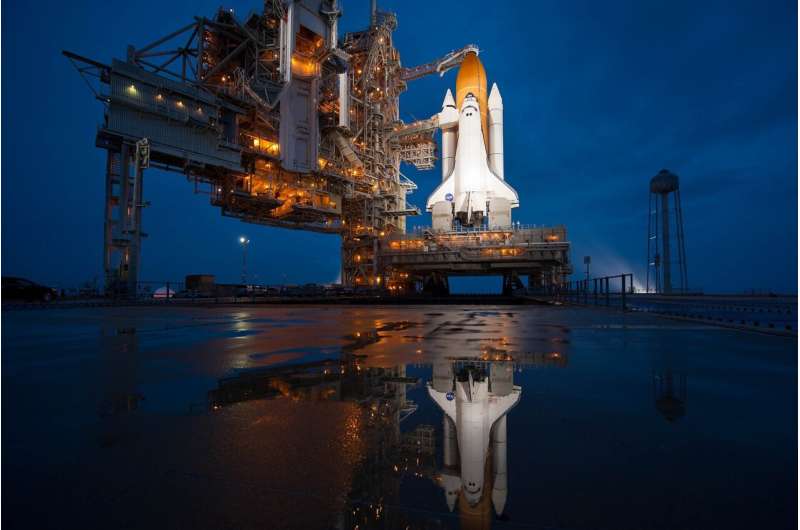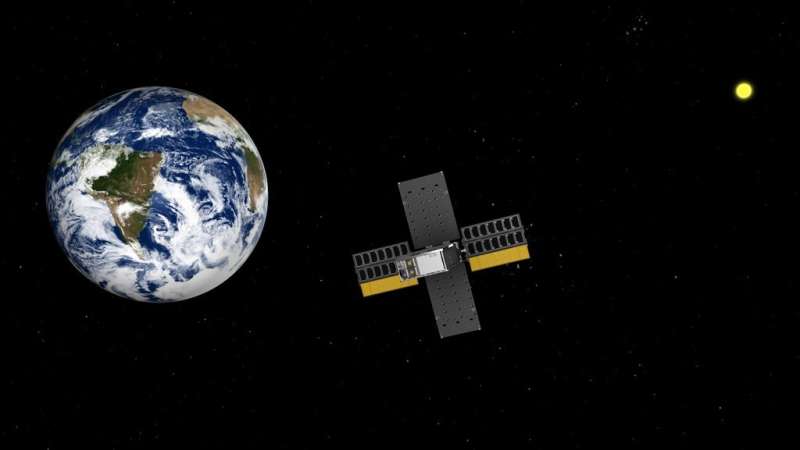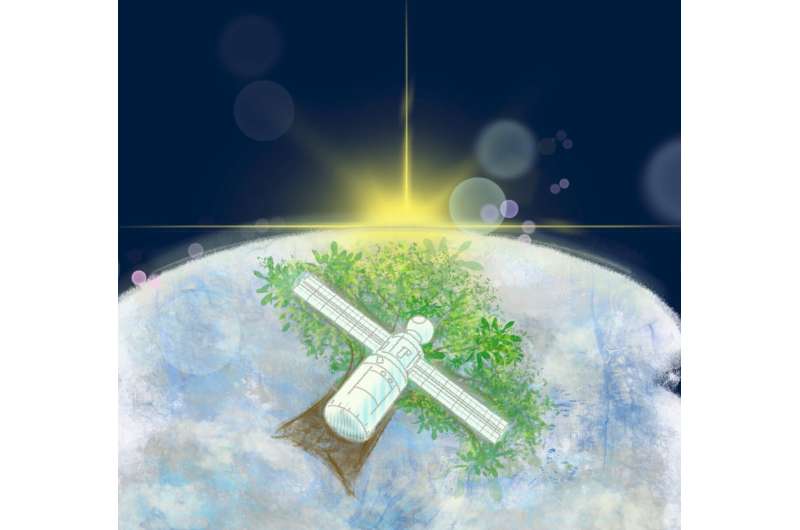
Copernical Team
Lunar Flashlight to fly by Earth
 With its primary mission over, the CubeSat will zoom by Earth late Tuesday, May 16, and NASA's Eyes on the Solar System app will track it, providing a chance to say farewell.
NASA's Lunar Flashlight mission to the Moon has ended, but the briefcase-size spacecraft will soon fly past Earth before heading into deep space. On Tuesday, May 16, at 9:44 p.m. PDT (Wednesday, May 17, at 12:44 a.m.
With its primary mission over, the CubeSat will zoom by Earth late Tuesday, May 16, and NASA's Eyes on the Solar System app will track it, providing a chance to say farewell.
NASA's Lunar Flashlight mission to the Moon has ended, but the briefcase-size spacecraft will soon fly past Earth before heading into deep space. On Tuesday, May 16, at 9:44 p.m. PDT (Wednesday, May 17, at 12:44 a.m. China continues testing its 130-ton reusable liquid oxygen kerosene engine
 China's National Space Agency has announced a significant achievement in the country's space propulsion development. The Xi'an Aerospace Propulsion Research Institute, known for its independent research and design capabilities, has successfully initiated two test runs of the 130-ton reusable liquid oxygen kerosene afterburning cycle engine. This milestone was achieved on the Tongchuan high-thrus
China's National Space Agency has announced a significant achievement in the country's space propulsion development. The Xi'an Aerospace Propulsion Research Institute, known for its independent research and design capabilities, has successfully initiated two test runs of the 130-ton reusable liquid oxygen kerosene afterburning cycle engine. This milestone was achieved on the Tongchuan high-thrus Ax-2 crew carrying personal, cultural mementoes on launch to ISS
 The second crew of astronauts set to launch on a totally private space mission said Tuesday they feel inspired by the responsibility and significance of their flight.
The four-member Axiom Space crew is scheduled to lift off at 5:37 p.m. EDT Sunday from Kennedy Space Center in Florida. They'll travel in a SpaceX Crew Dragon capsule on a mission that includes eight days aboard the Intern
The second crew of astronauts set to launch on a totally private space mission said Tuesday they feel inspired by the responsibility and significance of their flight.
The four-member Axiom Space crew is scheduled to lift off at 5:37 p.m. EDT Sunday from Kennedy Space Center in Florida. They'll travel in a SpaceX Crew Dragon capsule on a mission that includes eight days aboard the Intern Tomorrow.io paves way for new global weather forecasting service
 The Tomorrow Companies Inc., the world's leading weather intelligence platform, has announced successful on-orbit operation of its first satellite, Tomorrow-R1. Launched on April 14th, Tomorrow-R1 is the world's first commercially built weather-radar satellite.
It is orbiting at 500 km above Earth in a polar orbit, and carrying a Ka-band radar ideally suited for detecting precipitation and
The Tomorrow Companies Inc., the world's leading weather intelligence platform, has announced successful on-orbit operation of its first satellite, Tomorrow-R1. Launched on April 14th, Tomorrow-R1 is the world's first commercially built weather-radar satellite.
It is orbiting at 500 km above Earth in a polar orbit, and carrying a Ka-band radar ideally suited for detecting precipitation and Space waves offer new clues to space weather
 More accurate space weather predictions and safer satellite navigation through radiation belts could someday result from new insights into "space waves," researchers at Embry-Riddle Aeronautical University reported.
The group's latest research, published on May 4, 2023, by the journal Nature Communications, shows that seasonal and daily variations in the Earth's magnetic tilt, toward or aw
More accurate space weather predictions and safer satellite navigation through radiation belts could someday result from new insights into "space waves," researchers at Embry-Riddle Aeronautical University reported.
The group's latest research, published on May 4, 2023, by the journal Nature Communications, shows that seasonal and daily variations in the Earth's magnetic tilt, toward or aw NASA to announce a second Lunar lander partner for Moon Mission
 On May 19, at 10 a.m. EDT, the National Aeronautics and Space Administration (NASA) will unveil the second industry partner to collaborate on its groundbreaking Artemis V Moon mission. This momentous announcement will be broadcasted from NASA Headquarters in Washington, D.C., and will reveal the chosen organization to design and build a sustainable human landing system for our return to lunar ex
On May 19, at 10 a.m. EDT, the National Aeronautics and Space Administration (NASA) will unveil the second industry partner to collaborate on its groundbreaking Artemis V Moon mission. This momentous announcement will be broadcasted from NASA Headquarters in Washington, D.C., and will reveal the chosen organization to design and build a sustainable human landing system for our return to lunar ex Just 1 in 5 employees in the space industry are women—this lack of diversity is holding us back, say researchers

This week, the Australian Space Summit is celebrating some of our nation's strengths and achievements in the space sector. But it's taking place under the shadow of significant cuts to space technology investment announced in last week's federal budget.
Space technologies play a critical role in responding to many national priorities, such as climate and disaster resilience, connecting regional Australians, contributing to regional security and driving economic growth. Yet, the sector suffers from a branding issue—most people think of rockets and astronauts, rather than the satellites we depend on globally.
This leads to a misunderstanding in government of the importance of space technologies to the issues we are seeking to solve. It also makes it harder to recruit talented people to the field.
So, how do we find enough people with the skills necessary to grow this critical technology sector?
Why diversity and inclusivity matter
The answer is placing a new priority on talent recruitment and expanding diversity and inclusivity in the space sector.
The space sector needs workers from all different backgrounds and disciplines, but is struggling to attract a diverse talent pool.
NASA's Lunar Flashlight to fly by Earth

NASA's Lunar Flashlight mission to the moon has ended, but the briefcase-size spacecraft will soon fly past Earth before heading into deep space. On Tuesday, May 16, at 9:44 p.m. PDT (Wednesday, May 17, at 12:44 a.m. EDT), the CubeSat will pass about 40,000 miles (65,000 kilometers) from our planet's surface.
NASA's Eyes on the Solar System 3D visualization tool will track the tiny spacecraft in real time, giving users a front-row seat to the flyby.
Space test shows magnolia may be best for wooden artificial satellite LignoSat

An international project led by Kyoto University tested and confirmed the high durability of space wood at the International Space Station—the ISS. The experiment results showed minimal deterioration and good stability of the samples selected for the wooden artificial satellite LignoSat.
The research group conducted a preliminary inspection involving strength tests and elemental and crystal structural analyses of the wood samples, retrieved from space by Astronaut Koichi Wakata and returned to Earth from the ISS on SpaceX CRS-26—a Commercial Resupply Service mission.
Despite the extreme environment of outer space involving significant temperature changes and exposure to intense cosmic rays and dangerous solar particles for ten months, tests confirmed no decomposition or deformations, such as cracking, warping, peeling, or surface damage.
Three wood specimens were tested and showed no deformation after space exposure. The experiment results also confirmed no mass change in each wood specimen before and after space exposure.
NASA's Juno mission closing in on Io
 NASA's Juno spacecraft will fly past Jupiter's volcanic moon Io on Tuesday, May 16, and then the gas giant itself soon after. The flyby of the Jovian moon will be the closest to date, at an altitude of about 22,060 miles (35,500 kilometers). Now in the third year of its extended mission to investigate the interior of Jupiter, the solar-powered spacecraft will also explore the ring system where s
NASA's Juno spacecraft will fly past Jupiter's volcanic moon Io on Tuesday, May 16, and then the gas giant itself soon after. The flyby of the Jovian moon will be the closest to date, at an altitude of about 22,060 miles (35,500 kilometers). Now in the third year of its extended mission to investigate the interior of Jupiter, the solar-powered spacecraft will also explore the ring system where s 
